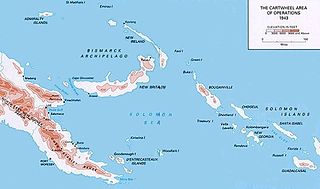
Operation Cartwheel (1943–1944) was a major military operation for the Allies in the Pacific theatre of World War II. Cartwheel was an operation aimed at neutralising the major Japanese base at Rabaul. The operation was directed by the Supreme Allied Commander in the South West Pacific Area (SWPA), General Douglas MacArthur, whose forces had advanced along the northeast coast of New Guinea and occupied nearby islands. Allied forces from the South Pacific Area, under Admiral William Halsey, advanced through the Solomon Islands toward Bougainville. The Allied forces involved were from Australia, the Netherlands, New Zealand, the US and various Pacific Islands.

The Battle of Tinian was part of the Pacific campaign of World War II, fought on the island of Tinian in the Mariana Islands from 24 July until 1 August 1944. The 8,000-man Japanese garrison was eliminated, and the island joined Saipan and Guam as a base for the Twentieth Air Force.

The Battle of Rabaul, also known by the Japanese as Operation R, an instigating action of the New Guinea campaign, was fought on the island of New Britain in the Australian Territory of New Guinea, from 23 January into February 1942. It was a strategically significant defeat of Allied forces by Japan in the Pacific campaign of World War II, with the Japanese invasion force quickly overwhelming the small Australian garrison, the majority of which was either killed or captured. Hostilities on the neighbouring island of New Ireland are usually considered to be part of the same battle. Rabaul was significant because of its proximity to the Japanese territory of the Caroline Islands, site of a major Imperial Japanese Navy base on Truk.

The New Georgia campaign was a series of land and naval battles of the Pacific Theater of World War II between Allied forces and the Empire of Japan. It was part of Operation Cartwheel, the Allied strategy in the South Pacific to isolate the Japanese base around Rabaul. The campaign took place in the New Georgia Islands in the central Solomon Islands and followed the Allied capture of the Russell Islands. The main fighting took place on New Georgia itself, although significant actions also took place around the island chain throughout the campaign.

Emirau Island, also called Emira, is an island in the Bismarck Archipelago located at 1°38.5′S149°58.5′E. It is currently part of the New Ireland Province of Papua New Guinea. The local language is a dialect of the Mussau-Emira language. Emira is part of what on many maps are charted as the St Matthias Islands, also known as the Mussau Islands, a small group to the northwest of the main island group of New Ireland. Early explorers named it Squally Island, a name found in some early records.

Operation Chronicle was the Allied invasion of Woodlark and Kiriwina Islands, in the South West Pacific, during World War II. The operation was a subordinate action that formed part of the wider Operation Cartwheel, the advance towards Rabaul. An early planning name for this operation was Operation Coronet. Preliminary actions commenced on 23–24 June 1943 when small reconnaissance parties were landed on both islands. The main operation was executed without opposition on 30 June 1943. Around 16,800 personnel took part, divided into two forces. The United States Army provided the majority of ground troops, which were supported by a United States Marine Corps defense battalion as well as U.S. and Australian aircraft and naval vessels.
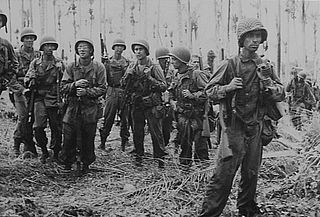
The New Britain campaign was a World War II campaign fought between Allied and Imperial Japanese forces. The campaign was initiated by the Allies in late 1943 as part of a major offensive which aimed to neutralise the important Japanese base at Rabaul, the capital of New Britain, and was conducted in two phases between December 1943 and the end of the war in August 1945.

The Battle of the Treasury Islands was a Second World War battle that took place between 27 October and 12 November 1943 on the Treasury Islands group, part of the Solomon Islands. The battle formed part of the wider Pacific War and involved New Zealand and US forces fighting against Japanese troops. The majority of the ground forces were provided by the New Zealand 3rd Division.
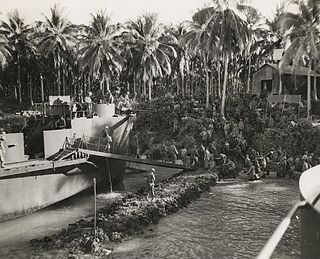
The Battle of the Green Islands or Operation Squarepeg was fought from 15 to 20 February 1944, between Imperial Japan and Allied forces from the New Zealand 3rd Division and the United States. Undertaken after landings to secure lodgments on New Britain and Bougainville, the main focus of the operation was the capture of Nissan Island, which was secured by New Zealand forces after only a short ground campaign. At only very limited cost in terms of casualties, the Allied operation resulted in the capture of several small atolls in the island chain, which were subsequently used to support air and naval operations focused on reducing the main Japanese base on Rabaul.
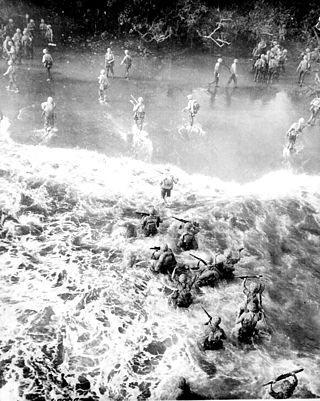
The Battle of Cape Gloucester was fought in the Pacific theater of World War II between Japanese and Allied forces on the island of New Britain, Territory of New Guinea, between 26 December 1943 and 16 January 1944. Codenamed Operation Backhander, the US landing formed part of the wider Operation Cartwheel, the main Allied strategy in the South West Pacific Area and Pacific Ocean Areas during 1943–1944. It was the second landing the US 1st Marine Division had conducted during the war thus far, after Guadalcanal. The objective of the operation was to capture the two Japanese airfields near Cape Gloucester that were defended by elements of the Japanese 17th Division.
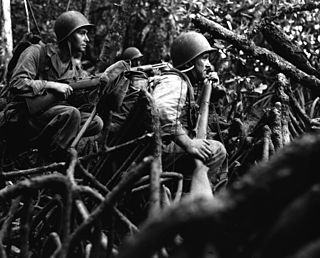
The Battle of Vella Lavella was fought from 15 August – 6 October 1943 between the Empire of Japan and the Allied forces from New Zealand and the United States at the end of the New Georgia campaign. Vella Lavella, an island located in the Solomon Islands, had been occupied by Japanese forces early during the war in the Pacific. Following the Battle of Munda Point, the Allies recaptured the island in late 1943, following a decision to bypass a large concentration of Japanese troops on the island of Kolombangara.

The Raid on Choiseul was a small unit engagement that occurred from 28 October to 3 November 1943, during the Solomon Islands campaign of the Pacific War. The raid was launched to divert the Japanese from the Allied landings at Cape Torokina on Bougainville Island.

The Battle of Arawe was fought between Allied and Japanese forces during the New Britain campaign of World War II. The battle formed part of the Allied Operation Cartwheel and had the objective of serving as a diversion before a larger landing at Cape Gloucester in late December 1943. The Japanese military was expecting an Allied offensive in western New Britain and was reinforcing the region at the time of the Allied landing in the Arawe area on 15 December 1943. The Allies secured Arawe after about a month of intermittent fighting with the outnumbered Japanese force.
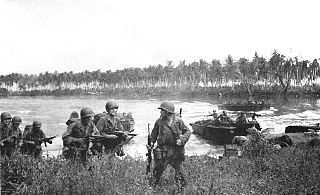
The Admiralty Islands campaign was a series of battles in the New Guinea campaign of World War II in which the United States Army's 1st Cavalry Division took the Japanese-held Admiralty Islands.

The Landings at Cape Torokina, also known as Operation Cherryblossom, took place at the beginning of the Bougainville campaign in World War II. The amphibious landings were carried out by elements of the United States Marine Corps in November 1943 on Bougainville Island in the South Pacific, as part of Allied efforts to advance towards the main Japanese base around Rabaul under Operation Cartwheel. Coming in the wake of Allied successes at Guadalcanal and in the central Solomons, the landings were intended to secure a beachhead with the purpose of establishing several bases from which to project air and naval power closer towards Rabaul, in an effort to neutralize the large Japanese force that had been established there.

The Battle of the Koromokina Lagoon was fought between the United States Marine Corps and Imperial Japanese Army forces on Bougainville Island. It took place on 7–8 November 1943 during the Bougainville campaign of the Pacific War.

The New Georgia counterattack was a counterattack on 17–18 July 1943 by mainly Imperial Japanese Army troops against United States Army forces during the New Georgia campaign in the Solomon Islands. The U.S. and its allies were attempting to capture an airfield constructed by the Japanese at Munda Point on New Georgia with which to support further advances towards the main Japanese base around Rabaul as part of Operation Cartwheel.

The Battle of Munda Point was a battle from 22 July – 5 August 1943 between primarily United States Army and Imperial Japanese Army forces during the New Georgia campaign in the Solomon Islands in the Pacific War. The battle took place following a landing by U.S. troops on the western coast of New Georgia from Rendova Island, as part of an effort to capture the Japanese airfield that had been constructed at Munda Point. This advance had become bogged down, and while the Allies brought forward reinforcements and supplies, the Japanese had launched a counterattack on 17–18 July. This effort was ultimately unsuccessful, and afterwards U.S. forces launched a corps-level assault to reinvigorate their effort to capture the airfield. Against this drive, Japanese defenders from three infantry regiments offered stubborn resistance but were ultimately forced to withdraw, allowing U.S. forces to capture the airfield on 5 August. The airfield later played an important role in supporting the Allied campaign on Bougainville in late 1943.

This is an order of battle listing the Allied and Japanese forces involved in the Battle of Arawe from 15 December 1943 to 24 February 1944.

The Battle of Talasea was a battle fought in the Pacific theater of World War II between Japanese and Allied forces. Dubbed "Operation Appease" by the Allies, the battle was part of the wider Operations Dexterity and Cartwheel, and took place on the island of New Britain, Territory of New Guinea, in March 1944 as primarily US forces, with limited Australian support, carried out an amphibious landing to capture the Talasea area of the Willaumez Peninsula, as part of follow-up operations as the Japanese began withdrawing east towards Rabaul following heavy fighting around Cape Gloucester earlier in the year. The assault force consisted of a regimental combat team formed around the 5th Marines, which landed on the western coast of the Willaumez Peninsula, on the western side of a narrow isthmus near the Volupai Plantation. Following the initial landing, the Marines advanced east towards the emergency landing strip at Talasea on the opposite coast. Their advance south was stymied by a small group of Japanese defenders who prevented the US troops from advancing quickly enough to cut off the withdrawal of the Japanese force falling back from Cape Gloucester.























